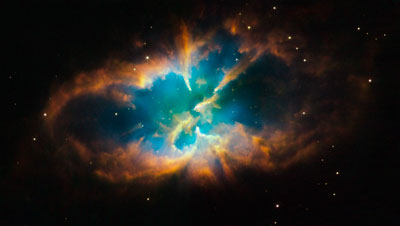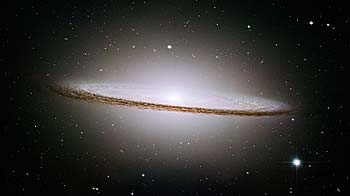A succinct definition of the Big Bang comes from Wikipedia: “The Big Bang is a cosmological model of the most comprehensive and accurate explanations from current scientific evidence and observation. As used by cosmologists, the term Big Bang generally refers to the idea that the universe has expanded from a primordial hot and dense initial condition at some finite time in the past, and continues to expand to this day.” In other words, the Big Bang Theory posits that between 13 and 15 billion years ago, all matter currently spread out across the universe was compressed into one infinitesimally small point in space, today referred to as a “singularity.” This “matter” was extremely dense and hot, and when released in a gigantic explosion, it began cooling and spreading out—forming atoms and later stars, planets, and galaxies. It continues to cool and expand to this day. At one time another theory, usually referred to as “Steady State,” was highly regarded and supported as a likely alternative. Steady State held that there was no “beginning” to the universe, but there was instead new matter being continuously created as the universe expanded. Very few scientists prefer the Steady State over the Big Bang today, as the latter has been more supportable by scientific evidence and observation. Einstein’s general relativity field equations provide the basis of the Big Bang Theory, and although largely unchanged from Einstein’s work of 1917, details and solutions to Einstein’s field equations continue to be developed. Various scientists have contributed to these details, including Georges Lemaitre in Belgium, William Sitter in Holland, Alexander Friedman in Russia, and Russian-American physicist George Gamow. American Astronomer Edwin Hubble provided some of the greatest supporting evidence for the theory in 1929, when he discovered that the light of distant galaxies was universally shifted toward the red end of the spectrum. This shift proved that the galaxies were moving away from each other at a rate proportional to their distance from the center of the universe—supporting the expansion aspects of the theory. Additional, significant support of the Big Bang was discovered in 1964, when two American astronomers, Arno Penzias and Robert Wilson, inadvertently discovered radiation from the farthest reaches of the universe, left over from the Big Bang. Further backup came in the early 1990’s by NASA’s Cosmic Background Explorer (COBE) satellite, which provided more accurate measurements of the background radiation discovered in 1964. Astrophysicist George Smoot verified that analysis concluded the background radiation “ripples” were exactly what they expected for support of the Big Bang Theory’s origin of the universe. Smoot was quoted as saying, “if you’re religious, it’s like looking at God.” A significant refinement to the Big Bang Theory was proposed by MIT’s Alan Guth (and, simultaneously, Alexei Starobinski of the Soviet Union) in 1979. In a nutshell, they proposed that there was a brief “inflationary” period in which the universe expanded at a rate exponentially faster than its subsequent rate. This rapid initial growth (when the universe was less than a second old and about the size of a baseball) solves various problems with the original Big Bang Theory, including why the universe resulted in large scale structures (i.e., stars, galaxies, and clusters of galaxies) rather than a scattering of atoms. So, what does science, through the Big Bang theory, tell us? It tells us how the universe expanded from an infinitely small point in time and space to its present size, 15 billion years later. But, what does science NOT tell us? “Science is good at telling us how, but not so good on the why.” Paul Davies, theoretical physicist. From “What Happened before the Big Bang?” at http://www.fortunecity.com/emachines/e11/86/big-bang.html Theoretical physicists, cosmologists, quantum physicists, quantum cosmologists, and other scientists are at work on this. A plethora of theories have been offered, involving pocket universes, multiple dimensions, parallel universes, and even a “megauniverse.” Scientists continue to pursue the elusive Theory of Everything, where they hope to combine general relativity with quantum mechanics in a theory that explains all fundamental interactions of nature. They hope that String Theory is key to this, but according to Lenny Susskind, who discovered String Theory: “String Theory, our best hope for a unified theory, is producing a landscape of enormous proportions. The best estimates of theorists are that 10500 distinct kinds of environments are possible.” (from http://www.edge.org/3rd_culture/susskind03/susskind_index.html) Proponents of these theories argue that mankind will eventually "get there." They will explain what caused the universe to come into existence--and many think that this can all be done without the need for God. Critics, myself among them, argue that no matter how far back you go, no matter how many pocket universes or parallel universes you theorize, you still have to get back to one thing: “You have to make something—matter, if you will—out of nothing. As Gottfried Leibniz concluded: "Not even by supposing the eternity of the world can we escape the ultimate, extramundane reason of things, i.e., God." Why do we have something instead of nothing? The laws and theories of today don’t even come close to explaining it. Einstein once said "We know nothing about [God, the world] at all. All our knowledge is but the knowledge of schoolchildren. Possibly we shall know a little more than we do now, but the real nature of things, that we shall never know, never." (The Expanded Quotable Einstein, Princeton University Press, p. 207) In regards to why we DO have something from nothing, I’ll take Einstein’s statement at face value: “I want to know how God created this world. I am not interested in this or that phenomenon, in the spectrum of this or that element. I want to know his thoughts. The rest are details. (The Expanded Quotable Einstein, Princeton University Press, 2000, p. 202) References: http://en.wikipedia.org/wiki/Big_Bang http://encarta.msn.com/encyclopedia_761570694/big_bang_theory.html http://www.umich.edu/~gs265/bigbang.htm http://www.big-bang-theory.com/ http://superstringtheory.com/cosmo/cosmo4.html http://www.edge.org/3rd_culture/susskind03/susskind_index.html http://www.fortunecity.com/emachines/e11/86/big-bang.html The Inflationary Universe, Alan Guth, Basic Books, 1997 The Expanded Quotable Einstein, Princeton University Press, 2000 Show Me God, Frank Heeren, Day Star Publications, 1998
What does science tell us with the Big Bang?
What does science NOT tell us?

Alan Guth, MIT physicist and developer of the Inflationary model of the Big Bang Theory, said: “[A]t the purely technical level, inflation itself does not explain how the universe arose from nothing . . . Inflation itself takes a very small universe and produces from it a very big universe. But inflation by itself does not explain where that very small universe came from.” From p. 174 of Heeren.
Andrei Linde, Russian-American theoretical physicist, writes: “Explaining this initial singularity—where and when it all began—still remains the most intractable problem of modern cosmology.” P. 48 of Linde, “The Self-Reproducing Inflationary Universe,” Scientific American (November 1994).
Scientists have yet to come up with a plausible explanation of what happened BEFORE the Big Bang. Why did we get SOMEthing from NOTHING?
"On the Ultimate Origination of Things" by G. W. Leibniz, Nov 23, 1697
Copyright 2009 Created Cosmos.com